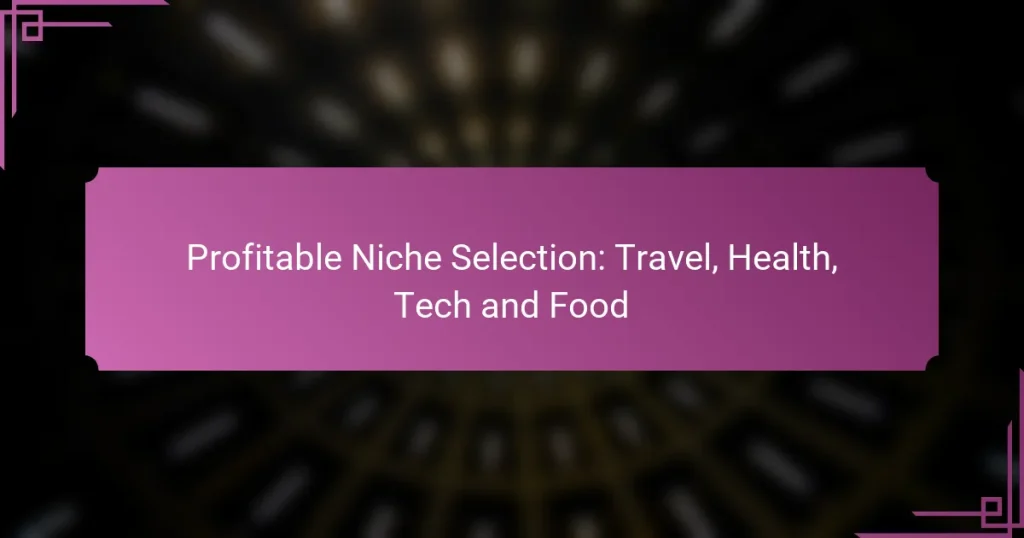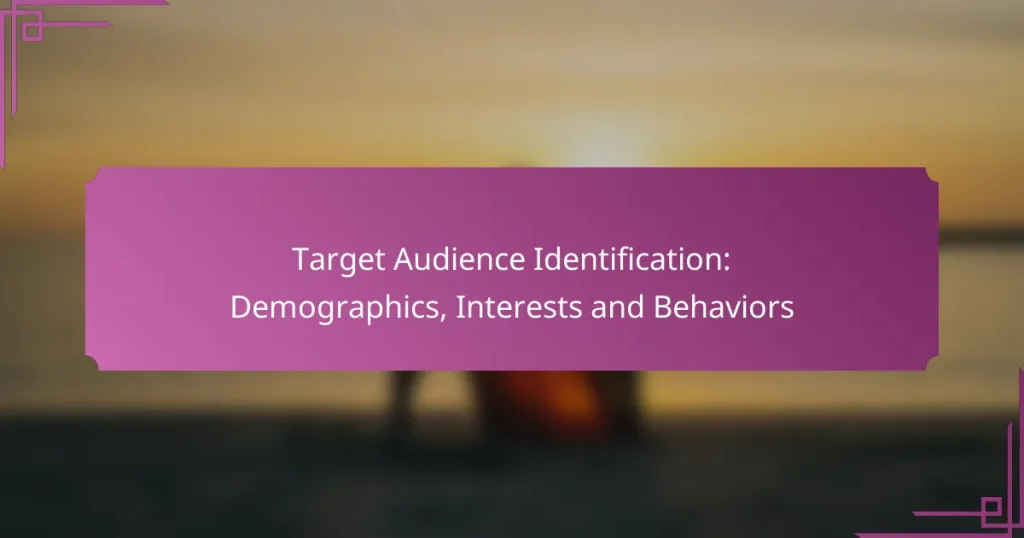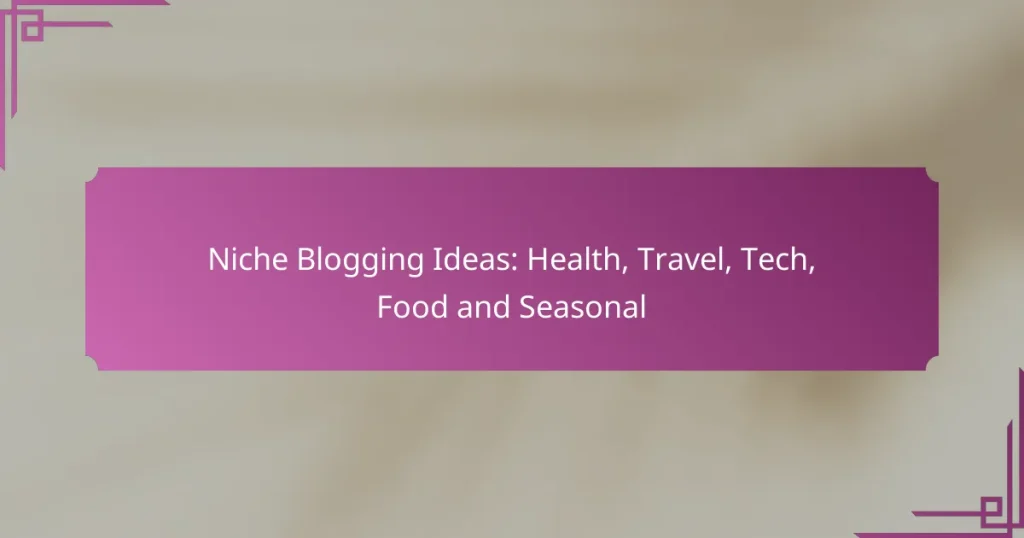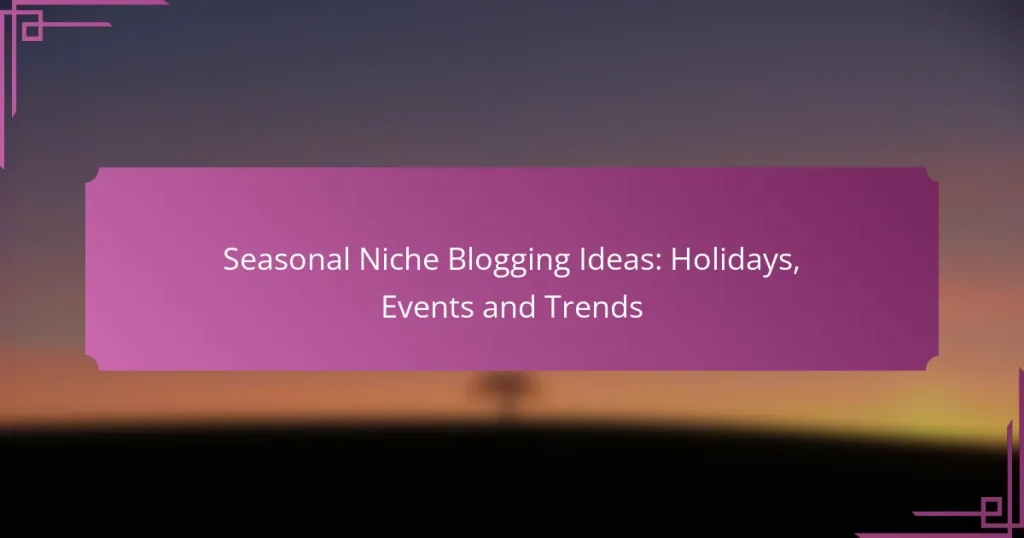Niche blogging presents a unique opportunity to connect with specific audiences by focusing on emerging trends and specialized interests. In 2024, popular topics include health and wellness, personal finance, and eco-friendly living, which not only attract dedicated readers but also offer various monetization strategies. By understanding your topic and audience, you can create engaging content that resonates and drives traffic to your blog.
Target Audience Identification: Demographics, Interests and Behaviors
Niche Blogging Ideas: Health, Travel, Tech, Food and Seasonal
Unique Blogging Ideas: Tech Trends, Innovations and Gadgets
Niche Blogging Ideas: Food, Recipes, Nutrition and Trends
Seasonal Niche Blogging Ideas: Holidays, Events and Trends
Popular Blogging Niches: Comparison, Selection and Suitability
What are the best niche blogging ideas for 2024?
In 2024, the best niche blogging ideas focus on emerging trends and specific interests that attract dedicated audiences. Topics such as health and wellness, personal finance, travel to lesser-known destinations, tech gadget reviews, and eco-friendly living are gaining traction and offer opportunities for engaging content.
Health and wellness topics
Health and wellness blogging continues to be a popular niche, with a focus on holistic approaches, mental health, and fitness trends. Topics like mindfulness, nutrition, and alternative therapies can resonate well with readers seeking to improve their well-being.
Consider creating content around specific diets, workout plans, or mental health strategies. Engaging with your audience through personal stories or expert interviews can enhance credibility and foster community.
Personal finance tips
Personal finance is a critical area for many individuals looking to manage their money better. Blogging about budgeting, saving strategies, and investment tips can attract readers eager to improve their financial literacy.
Focus on practical advice, such as creating a monthly budget or understanding different investment vehicles. Providing tools like budget templates or calculators can add value and encourage reader engagement.
Travel experiences in lesser-known destinations
Travel blogging about lesser-known destinations offers a unique angle that appeals to adventurous travelers. Highlighting off-the-beaten-path locations can attract readers looking for authentic experiences away from tourist crowds.
Share personal anecdotes, itineraries, and tips for navigating these hidden gems. Including local customs, food recommendations, and budget considerations can enrich your content and provide practical insights for your audience.
Tech gadget reviews
Tech gadget reviews remain a popular niche as consumers seek informed opinions before making purchases. Focusing on the latest gadgets, software, and tech trends can help establish your blog as a trusted resource.
Provide detailed comparisons, pros and cons, and user experiences to help readers make informed decisions. Including video reviews or unboxing experiences can enhance engagement and provide a more dynamic presentation of your content.
Eco-friendly living
Eco-friendly living is increasingly relevant as more people seek sustainable lifestyle choices. Blogging about green products, zero-waste practices, and sustainable fashion can resonate with environmentally conscious readers.
Offer practical tips for reducing waste, such as DIY projects or eco-friendly product recommendations. Highlighting local initiatives or businesses that support sustainability can also foster community engagement and inspire readers to take action.
How can I monetize my niche blog?
Monetizing a niche blog involves several strategies that can generate income. The most effective methods include display advertising, affiliate marketing, and sponsored content partnerships, each offering unique benefits and considerations.
Display advertising strategies
Display advertising allows you to earn money by placing ads on your blog. You can use networks like Google AdSense, which pays based on impressions or clicks. The key is to optimize ad placement and ensure they do not disrupt the user experience.
Consider the size and format of the ads; larger ads may attract more attention but can also slow down your site. Aim for a balance between visibility and site performance, and regularly analyze your ad performance to make adjustments.
Affiliate marketing opportunities
Affiliate marketing involves promoting products or services and earning a commission for each sale made through your referral link. Choose affiliate programs that align with your niche to maintain credibility with your audience.
To succeed, create high-quality content that naturally incorporates affiliate links, such as reviews or tutorials. Track your conversions and optimize your strategies based on what resonates with your readers, ensuring compliance with disclosure regulations.
Sponsored content partnerships
Sponsored content partnerships involve collaborating with brands to create content that promotes their products or services. This can be a lucrative option, especially if your blog has a dedicated following.
When seeking sponsorships, ensure that the brands align with your niche and values. Clearly disclose sponsored content to maintain transparency with your audience and adhere to advertising standards. Establishing long-term relationships with brands can lead to more consistent income streams.
What are the prerequisites for starting a niche blog?
To start a niche blog, you need a clear understanding of your chosen topic, a target audience, and a blogging platform. Additionally, familiarity with content creation and basic marketing strategies will help you effectively reach and engage your audience.
Identifying your target audience
Identifying your target audience is crucial for a successful niche blog. Start by defining the demographics, interests, and pain points of the readers you want to attract. This will guide your content creation and marketing efforts.
Consider conducting surveys or using social media analytics to gather insights about potential readers. Aim for a specific niche within a broader category to differentiate your blog and appeal to a dedicated audience.
Choosing a blogging platform
Selecting the right blogging platform is essential for ease of use and functionality. Popular options include WordPress, Blogger, and Wix, each offering different features and customization levels. WordPress is often favored for its flexibility and extensive plugin ecosystem.
Evaluate your technical skills and the specific needs of your niche when choosing a platform. For instance, if you plan to monetize your blog, ensure the platform supports ad placements and e-commerce features.
Setting up a content calendar
A content calendar helps you plan and organize your blog posts effectively. Start by mapping out topics, publication dates, and promotional strategies for each piece of content. This ensures a consistent posting schedule, which is vital for audience retention.
Consider using tools like Google Calendar or Trello to manage your content calendar. Aim to plan at least a month in advance, allowing flexibility for timely topics or trends that may arise in your niche.
What are effective content strategies for niche blogging?
Effective content strategies for niche blogging focus on targeting a specific audience with tailored content that meets their needs. This involves understanding your niche, optimizing for search engines, engaging on social media, and building a loyal email list.
SEO optimization techniques
SEO optimization techniques are essential for increasing visibility in search engines. Start by conducting keyword research to identify terms your target audience is searching for, then incorporate these keywords naturally into your content, titles, and meta descriptions.
Consider on-page SEO factors such as using header tags, optimizing images with alt text, and ensuring your site is mobile-friendly. Regularly updating content and obtaining backlinks from reputable sites can also boost your search engine rankings.
Engaging with social media
Engaging with social media is crucial for promoting your niche blog and connecting with your audience. Choose platforms that align with your niche, such as Instagram for visual content or LinkedIn for professional topics, and share your blog posts regularly.
Interact with followers by responding to comments, asking questions, and participating in relevant discussions. Utilizing social media analytics can help you understand which content resonates most with your audience, allowing you to refine your strategy.
Building an email list
Building an email list is a powerful way to maintain direct communication with your audience. Offer incentives like exclusive content, discounts, or free resources in exchange for email sign-ups. Make sure to clearly communicate the value of subscribing to your list.
Use email marketing tools to segment your audience and personalize your messages. Regularly send newsletters with updates, blog highlights, and tailored content to keep your subscribers engaged and encourage repeat visits to your blog.
How do I choose a niche for my blog?
Choosing a niche for your blog involves identifying a specific topic that aligns with your interests and has an audience. Focus on areas where you can provide unique insights or solutions, ensuring there is sufficient demand and engagement.
Identify your passions and expertise
Start by listing your interests and areas where you have knowledge or experience. This could include hobbies, professional skills, or personal experiences. The more passionate you are about a topic, the more likely you are to create engaging content consistently.
Consider how your expertise can provide value to others. For example, if you are a skilled cook, a food blog focusing on healthy recipes could attract an audience looking for nutritious meal ideas.
Research market demand
Use tools like Google Trends, keyword research tools, or social media platforms to gauge interest in your potential niche. Look for topics that have a steady search volume and active discussions online. This helps ensure that there is an audience eager for content in your chosen area.
Evaluate existing blogs in your niche to identify gaps in content or underserved topics. This can provide opportunities for you to stand out by offering unique perspectives or specialized information.
Assess competition
Analyze the competition within your chosen niche. A niche with high competition may require more effort to gain visibility, while a less competitive niche might offer easier entry but could lack audience size. Aim for a balance where you can differentiate yourself while still reaching a substantial audience.
Tools like SEMrush or Ahrefs can help you assess the competition by providing insights into traffic, keywords, and content strategies of existing blogs. Consider how you can offer something different or better than what is currently available.
Define your target audience
Understanding your target audience is crucial for niche blogging. Define who you want to reach based on demographics, interests, and needs. This clarity will guide your content creation and marketing strategies.
Create audience personas to visualize your ideal readers. Consider factors such as age, gender, location, and preferences. For instance, if your niche is personal finance, your audience may include young professionals looking for budgeting tips or retirees seeking investment advice.
Test and refine your niche
Once you have a niche in mind, start creating content and monitor its performance. Use analytics tools to track engagement, traffic, and audience feedback. This will help you understand what resonates with your readers and what may need adjustment.
Be open to refining your niche based on feedback and trends. If you notice a particular topic gaining more traction, consider focusing more on that area to better serve your audience’s interests.






